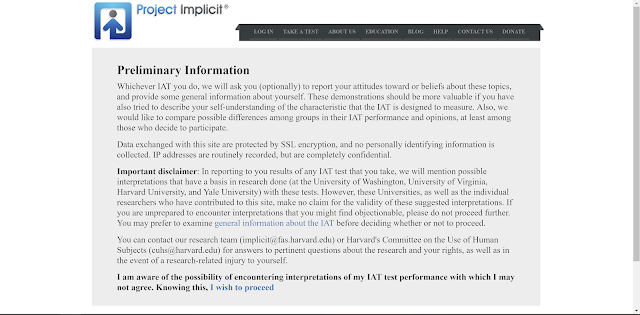3. Trying Out The Implicit Association Test (Part 1)
Keeping in line with the train of thought of inclusivity, bias, and human connection, I recalled that an episode of the Invisibilia podcast mentioned something called the Implicit Bias Test. After doing a quick search, I found Project Implicit, or the Implicit Association Test, developed by social psychology researchers Anthony Greenwald and Mahzarin Banaji. The purpose of the test was to gauge the difference between self-reported (explicit) bias in terms of factors such as skin tone preference versus implicit bias which might occur in individuals without their conscious realisation. The test measures the speed and accuracy in which a participant can categorise certain traits with certain groups of people - the faster they can associate positive or negative words with certain groups, the stronger the bias they might have for or against that group.
I took a few of these tests in one go (skin tone, weight, gender/science), and I went back to the skin tone test to take screenshots to illustrate the test process.
The participant is first greeted with a disclaimer on the process and validity of the test, and how "if you are unprepared to encounter interpretations that you might find objectionable, please do not proceed further". The participant is then asked to confirm that they are aware that they may not agree with their test results to proceed further.
References:
Greenwald, T., Banaji, M., Nosek, B. (1998). Project Implicit. Available at: http://www.projectimplicit.net/about.html
Greenwald, A., McGhee, D. and Schwartz, J. (1998). Measuring individual differences in implicit cognition: The implicit association test. Journal of Personality and Social Psychology, [online] 74(6), pp.1464-1480. Available at: http://psycnet.apa.org/fulltext/1998-02892-004.html.
I took a few of these tests in one go (skin tone, weight, gender/science), and I went back to the skin tone test to take screenshots to illustrate the test process.
The participant is first greeted with a disclaimer on the process and validity of the test, and how "if you are unprepared to encounter interpretations that you might find objectionable, please do not proceed further". The participant is then asked to confirm that they are aware that they may not agree with their test results to proceed further.
The participant is then shown a list of Implicit Association Tests to choose from, ranging from skin tone and race, to religion and what presidents they might prefer.
After the participant chooses a test, they are shown the explanation for how the test works.
The participant then needs to fill out a questionnaire about themselves, including basic information on their age, gender, political leanings, education level, and religiosity level. They are also asked questions concerning the test they are taking, and whether they think they have any biases. The participant can choose not to answer any or all the questions if they choose.
The test starts with showing the participant all the possible words and images, and the groups they are in.
Next, the participant is asked to place their fingers on the "E" and "I" keys on their keyboard, and asked to match the images (of people with different skin tones) that show up in the middle of the screen with either the right or left side. They are asked to go as fast as they can while trying to be accurate. 

The participant first matches either the skin tone images or the words separately, but later on the images and words are grouped to either the left or right side. 

At the end of the test, the participant is given their result, which can range between "Strong", "Moderate", and "Slight" preferences for or against light or dark skinned people. The participant is asked to answer a few more questions about how they found out about the test and how they feel about their results, before being directed to the full analysis of their results.
I feel like this post is getting a little too long, so I'll make a part 2 to break down the results and also talk about the research methodology, as well as its strengths and weaknesses.
References:
Greenwald, T., Banaji, M., Nosek, B. (1998). Project Implicit. Available at: http://www.projectimplicit.net/about.html
Greenwald, A., McGhee, D. and Schwartz, J. (1998). Measuring individual differences in implicit cognition: The implicit association test. Journal of Personality and Social Psychology, [online] 74(6), pp.1464-1480. Available at: http://psycnet.apa.org/fulltext/1998-02892-004.html.








Comments
Post a Comment